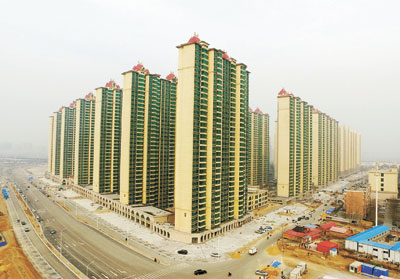
CHINA’S home prices rose for a fourth straight month in January with big cities leading the gains, suggesting an uneven recovery in the housing market as the government’s pro-growth policies gain traction.
The mild recovery in China’s housing market, which accounts for 15 percent of GDP, is the most visible example of policy supporting demand in the country, as the rest of the economy struggles amid wider restructuring and slowing global demand.
Average new-home prices in 70 major cities rose 2.5 percent in January from a year earlier, quickening from December’s 1.6 percent rise, according to Reuters calculations based on data from the National Bureau of Statistics (NBS).
The NBS data showed Shenzhen continued to be the top performer, where home prices surged 51.9 percent in January from a year ago, followed by Shanghai with a 17.5 percent increase. However, developers say Shanghai is likely to replace Shenzhen as the top performer in 2016.
“Shanghai’s home prices may take the lead this year due to limited supply and surging demand,” said Robert Song, the general manager of developer Pangu Realty in Shanghai.
“Since the market is relatively loose, we’re wondering whether we should make the most of the opportunity to buy more land and speed up construction.”
While a slew of government measures and increased lending helped boost the housing market, a huge overhang of unsold homes in smaller cities has limited rises in home prices in those centers.
Compared with average price gains of over 20 percent in first-tier cities and 1 percent rises in second-tier cities, home prices in most third-tier cities still saw year-on-year price drops though they were flat in January compared with the previous month.
China’s housing market bottomed out in the second half of 2015 after cooling for more than a year, propped up by a barrage of government support measures, including a series of interest rate cuts and lower down payment requirements.
To boost the housing market, China cut down payments again this month for first- and second-time home buyers and lowered transaction taxes for some home buyers.
The latest data showed home price gains spread to more cities with year-on-year prices rising in 25 of 70 major cities tracked by the NBS, up from 21 in December.
While economists attributed the recovery in the housing market to easing measures, some worry massive cash injections may once again flow into the property market.
“This is another asset bubble due to extremely accommodative monetary policy. For those who have excess liquidity to allocate, they need to find a safe place to park their money,” said Zhou Hao, senior Emerging Markets Economist at Commerzbank in Singapore.
As month-on-month home prices in third-tier cities stop falling, some developers expect China’s property recovery to expand to smaller cities.
Home prices in third and fourth-tier cities should pick up this year because of increased demand from residents to upgrade their existing housing, said Mo Bin, the president of Chinese developer Country Garden.
Despite this, Country Garden — which used to focus on lower-tier cities — expects 70 percent of its total sales to come from upper-tier cities in 2016, up from 60 percent in 2015.
(SD-Agencies)
|

